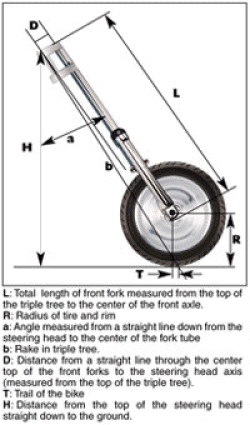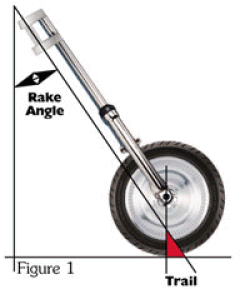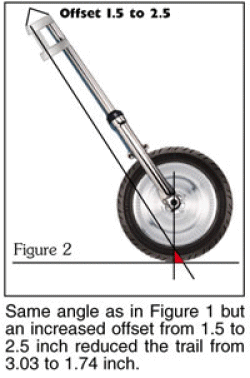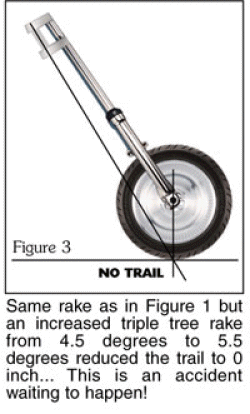What is Rake? Rake is the angle of the steering head measured in degrees from a line 90 degrees to the ground.
The next term we need to understand is "trail". Trail is the distance between an imaginary line drawn trough the steering head to the ground and a line straight down from the axle (See figure 1).
Trail is what gives us our handling characteristics of our motorcycle. The more trail we have the better our bike handles in a straight line at the cost of low speed turning ability. The less trail we have gives us very responsive low speed handling at the penalty of twitchy higher speed response.
Let's think about different ways to change rake and trail. Most Harley® riders make changes in their bikes rake without realizing it. One of the most common modifications to our bikes is to lower the rear end. As the rear of the bike goes down the steering head angle steepens increasing the rake and trail.

A change in wheel overall diameter like a 21 to a 19 will lower the front axle, lessening the steering head angle reducing rake and trail. Increasing fork tube length will increase rake and trail, but a front end lowering kit by itself will decrease it. Stock HD® front ends come with various rakes from 28 to 33 degrees. A good handling bike for highway use will have 2.5 to 6 inch trail.
There are two other things that affect our geometry. Offset, which is the distance the fork tube centerlines share in relation to the steering head centerline. And the infamous "raked triple tree", that has the fork tubes mounted in the trees at an angle to the steering post.

Before we start on raked tree, let's study how offset affects us. The steering head is in a relatively fixed position for us. To achieve the maximum trail for a give rake ideally our tubes would be in line and parallel to the steering head. This would however give us clearance problems with our fuel tank and possibly limit our turning radius. By moving the fork tubes in front of the steering head, we give ourselves more room but at the cost of decreased trail. This happens because the axle is closer to the point the line intersects the ground
(See figure 2).

Remember back in earlier in our essay that for good highway handling, we need specific trail numbers? With a raked tree, it's easy to get outside that guideline and become an accident waiting to happen. The most common result is a high speed wobble or worse, a tank slapper. For those of you that have not experienced this terrifying effect, take my word for it, that it's not a pleasant thing to have occur.
Some of our most experienced riders (readers) may point out that "Mother Harley®" produced a variable raked tree. These trees where designed for the rider that had a sidecar. The trees had two positions. With the hack in place, the trees where extended to the raked position. This helped the sidecars stability. When the sidecar was removed, the trees where returned to the original de-raked position.
